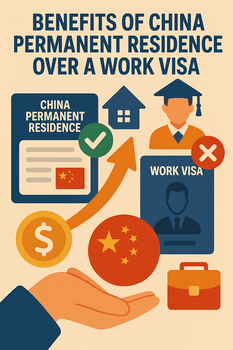
China’s permanent residence (PR) status, often referred to as a “China Green Card,” offers significant advantages compared to a standard work visa.
However, the decision between these two options requires careful consideration of eligibility requirements, application processes, and practical benefits.
This comprehensive guide examines both pathways based on the latest 2025 policies and data.
Understanding China’s Immigration Framework
China maintains one of the world’s most selective immigration systems, with fewer than 10,000 new permanent residence cards issued in 2023 despite hosting approximately 845,000 foreign workers, according to the National Immigration Administration.
| Immigration Status | Annual Approvals (2023) | Approval Rate | Primary Purpose |
|---|---|---|---|
| Work Permits (All Classes) | ~250,000 | 50-80% (varies by class) | Temporary employment |
| Permanent Residence | <10,000 | <1% of applications | Long-term settlement |
Source: National Immigration Administration, 2023 Guidelines
Work Visa System: The Three-Tier Classification
Since 2017, China has operated a three-tier classification system for work permits that significantly impacts eligibility and benefits.
| Category | Points Threshold | Target Applicants | Approval Rate | Validity |
|---|---|---|---|---|
| Class A (High-end talent) | 85+ points | C-suite executives, top scientists, specialized experts | 70-80% | 2-5 years |
| Class B (Professional talent) | 60-84 points | Mid-level managers, teachers, engineers | 50-60% | 1-2 years |
| Class C (Limited quota) | Below 60 points | Short-term workers, specific positions | 30-40% | Up to 1 year |
Source: IkkyInChina: China Work Visa vs. Permanent Residence
Permanent Residence Eligibility Pathways
China’s permanent residence remains highly selective, with specific pathways each having distinct requirements:
| Pathway | Key Requirements (2025) | Approval Difficulty |
|---|---|---|
| High-level talent | International recognition, contributions to key national projects | <5% approval rate |
| Investment-based | USD 3-10M investment (region dependent), 3+ years stable operation | 10-15% approval rate |
| Family reunification | Marriage to Chinese citizen for 5+ years, 5 years residence | 20-30% approval rate |
| Specialized talent | 4+ years in China, annual salary ≥RMB 886,104, tax payment ≥RMB 177,221 | 15-20% approval rate |
| Scientific research | Leading researchers, full professors at top universities | 20-25% approval rate |
Source: SJ Grand: Permanent Residence Requirements 2025
Key Benefits Comparison: Stability and Long-Term Residency
Duration and Renewal Requirements
Work permits require regular renewals and employer sponsorship, while permanent residence offers long-term stability.
| Aspect | Work Permit (Class A) | Work Permit (Class B/C) | Permanent Residence |
|---|---|---|---|
| Initial validity | 2-5 years | 1-2 years | Indefinite (card renewal every 10 years) |
| Renewal process | Employer-sponsored | Employer-sponsored | Simple administrative renewal |
| Documentation for renewal | Comprehensive | Comprehensive | Minimal |
| Processing time | 2-4 weeks | 2-4 weeks | 4-8 weeks for card renewal |
Source: IkkyInChina: Work Visa vs. Permanent Residence Comparison
Employment Flexibility and Career Mobility
One of the most significant advantages of permanent residence is employment freedom.
| Aspect | Work Visa | Permanent Residence |
|---|---|---|
| Change employers | Requires new application and visa transfer | Complete freedom |
| Start a business | Requires additional permits and approvals | No restrictions |
| Industry limitations | May be restricted to specific sectors | No limitations |
| Geographic restrictions | May be limited to specific regions | Nationwide validity |
| Unemployment period | Limited (typically 30 days) | Unlimited |
The employment flexibility alone makes permanent residence worth pursuing for those who qualify, Work visa holders are essentially tied to their sponsoring employer, while permanent residents can pursue opportunities anywhere in China.
James Chen, Managing Director of Asia Briefing.
Public Services and Social Benefits
Healthcare Access
| Aspect | Work Visa | Permanent Residence |
|---|---|---|
| Public healthcare access | Limited | Full access similar to citizens |
| Insurance requirements | Employer-provided or private | Can join public insurance |
| Hospital registration | Foreign patient process | Local patient process |
| Medical costs | Often higher rates for foreigners | Standard local rates |
Education Opportunities
| Aspect | Work Visa | Permanent Residence |
|---|---|---|
| Public school access | Limited, often with foreign student fees | Equal access with local rates |
| University admission | International student track | Can qualify for domestic student status |
| Education subsidies | Generally not eligible | May be eligible for certain subsidies |
Source: IkkyInChina: How Permanent Residents Can Access Education in China
Economic Advantages and Property Rights
Investment and Business Opportunities
| Aspect | Work Visa | Permanent Residence |
|---|---|---|
| Property purchase | Limited to one property after 1 year | No restrictions |
| Business ownership | Possible with additional permits | Full rights |
| Investment opportunities | Some restrictions | Equal to citizens |
| Banking services | Limited | Full access |
Tax Considerations
While permanent residence offers many advantages, it also comes with potential tax implications:
| Aspect | Work Visa | Permanent Residence |
|---|---|---|
| Tax on China income | Yes | Yes |
| Global income reporting | Generally no | Potential requirement |
| Tax treaties application | Standard foreign treatment | May vary |
“Permanent residents should be aware that their status may trigger global income reporting requirements in certain circumstances,” advises Dr. Liu Wei, former official at the National Immigration Administration. “This is an important consideration for high-net-worth individuals.”
Travel and Mobility Benefits
| Aspect | Work Visa | Permanent Residence |
|---|---|---|
| Entry/exit requirements | Visa validation | No visa needed |
| Multiple entries | Requires specific visa type | Unlimited |
| Maximum stay abroad | Limited (may affect renewal) | More flexible |
| Travel within China | May require additional registration | Simplified process |
| “Five-star Card” benefits | Not applicable | Enhanced security features and functionality (introduced Dec 2023) |
Source: SJ Grand: Permanent Residence Requirements 2025
Application Process and Costs
The application processes differ significantly in complexity, timeline, and cost:
| Factor | Work Permit | Permanent Residence |
|---|---|---|
| Processing time | 4-8 weeks | 6-12 months |
| Application fee | RMB 1,000 | RMB 1,500 |
| Professional services (typical) | RMB 5,000-15,000 | RMB 30,000-100,000 |
| Document authentication | RMB 2,000-5,000 | RMB 5,000-15,000 |
| Medical examination | RMB 500-1,500 | RMB 1,000-2,000 |
| Total typical costs | RMB 8,500-22,500 | RMB 37,500-118,500 |
Source: IkkyInChina: Key Differences in Eligibility for Work Permits and Permanent Residence
Regional Variations and Special Programs
China’s immigration policies show significant regional differences, with certain areas offering more accessible pathways:
| Region | Special Policies | Target Industries | PR Success Rates |
|---|---|---|---|
| Shanghai | Points-based system; lower thresholds for tech | Integrated circuits, AI, biomedicine | Highest nationwide (~0.2% of foreign residents) |
| Beijing | Focus on scientific research | Advanced computing, quantum technology | Second highest (~0.15% of foreign residents) |
| Greater Bay Area | Talent passport program | Finance, advanced manufacturing, R&D | Growing rapidly (doubled 2020-2023) |
| Hainan Free Trade Port | Reduced income requirements | Tourism, modern services, high-tech agriculture | Newest program (limited data) |
Source: IkkyInChina: Regional Green Card Policies
Strategic Considerations: Which Option Is Right For You?
When to Pursue a Work Visa
A work visa remains the most practical option for most foreigners in China:
- You’re in the early stages of your China career
- You have a specific job offer with employer support
- You don’t yet meet the high thresholds for permanent residence
- You want to test living in China before making a longer commitment
- You prefer flexibility to leave China without residency obligations
When to Pursue Permanent Residence
Consider permanent residence if:
- You’ve established long-term personal or professional roots in China
- You meet one of the eligibility pathways (investment, talent, family, etc.)
- You seek employment mobility and independence from a single employer
- You want maximum stability and access to public services
- You plan to stay in China indefinitely
Expert Recommendations
According to Wang Li, immigration attorney at Global Law Partners in Shanghai:
“Most foreign professionals should focus first on securing Class A work permit status rather than immediately pursuing permanent residence. Build a track record of contributions to China’s priority sectors over 4-5 years, maintain strong institutional support, and only then consider permanent residence if you have truly exceptional qualifications or contributions.”
Conclusion: Making an Informed Decision
While China’s permanent residence offers significant advantages over a work visa, the extremely selective nature of the program means it remains inaccessible to most foreign nationals.
The work visa system, particularly Class A status, provides a practical pathway for professional opportunities in China with reasonable benefits.
For those who qualify, permanent residence delivers unmatched stability, freedom, and integration into Chinese society.
However, the application process requires substantial investment of time, money, and documentation, with no guarantee of approval.
Your decision should be based on a realistic assessment of your qualifications, long-term goals in China, and willingness to navigate a complex application process.
For most foreigners, the journey begins with a work visa, potentially leading to permanent residence after establishing significant contributions to Chinese society or economy.


